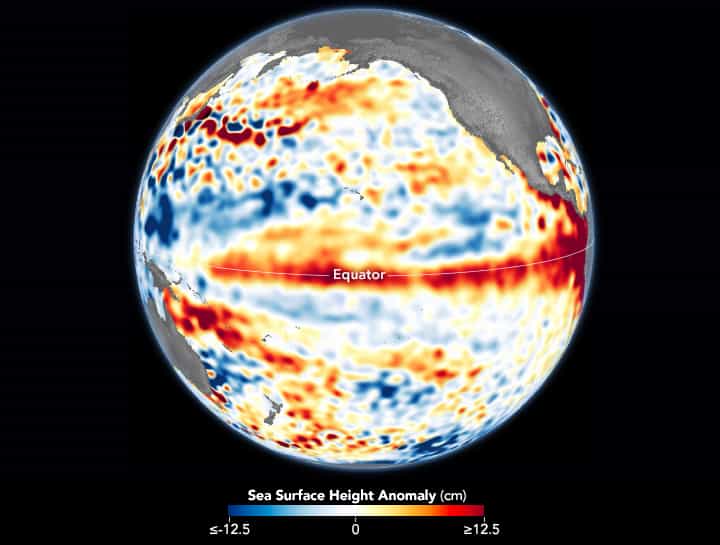
After three consecutive years of La Niña, spring 2023 saw the return of El Niño—a natural climate phenomenon characterized by the presence of warmer than normal sea surface temperatures (and higher sea levels) in the central and eastern tropical Pacific Ocean.
El Niño is associated with the weakening of easterly trade winds and the movement of warm water from the western Pacific toward the western coast of the Americas. The phenomenon can have widespread effects, often bringing cooler, wetter conditions to the U.S. Southwest and drought to countries in the western Pacific, such as Indonesia and Australia.
Satellite- and ocean-based measurements of sea surface temperature are one way to detect the arrival of El Niño. Its signature also shows up in satellite measurements of sea surface height, which rises as ocean temperatures warm up. That’s because warmer water expands to fill more volume, while cooler water contracts.
The map above depicts sea surface height anomalies across the central and eastern Pacific Ocean as observed from June 1–10, 2023. Shades of blue indicate sea levels that were lower than average; normal sea level conditions appear white; and reds indicate areas where the ocean stood higher than normal.
Data for the map were acquired by the Sentinel-6 Michael Freilich and Sentinel-3B satellites and processed by scientists at NASA’s Jet Propulsion Laboratory (JPL). Note that signals related to seasonal cycles and long-term trends have been removed to highlight sea level anomalies associated with El Niño and other short-term natural phenomena.
In a report released on June 8, 2023, the NOAA Climate Prediction Center declared El Niño conditions were present. The report pointed to sea surface temperatures in the Niño 3.4 region of the tropical Pacific (from 170° to 120° West longitude) that in May 2023 were 0.8°C (1.4°F) above the long-term average.
Forecasters expected El Niño conditions to gradually strengthen into the 2023–2024 Northern Hemisphere winter, by which time they called for a 60 percent chance of a moderate strength El Niño developing and a 56 percent chance of a strong El Niño.
As of June 2023, however, El Niño was not as far along as past El Niño events by the same time of year, according to Josh Willis, an oceanographer and Sentinel-6 Michael Freilich project scientist at JPL.
“It’s still a bit too early to say whether this will be a big one,” Willis said. “It will probably have some global impacts, but there’s still time for this El Niño to underwhelm.”
This post first appeared on NASA Earth Observatory. NASA Earth Observatory image by Lauren Dauphin, using modified Copernicus Sentinel data (2023) processed by the European Space Agency and further processed by Josh Willis, Severin Fournier, and Kevin Marlis/NASA/JPL-Caltech. Story by Kathryn Hansen.